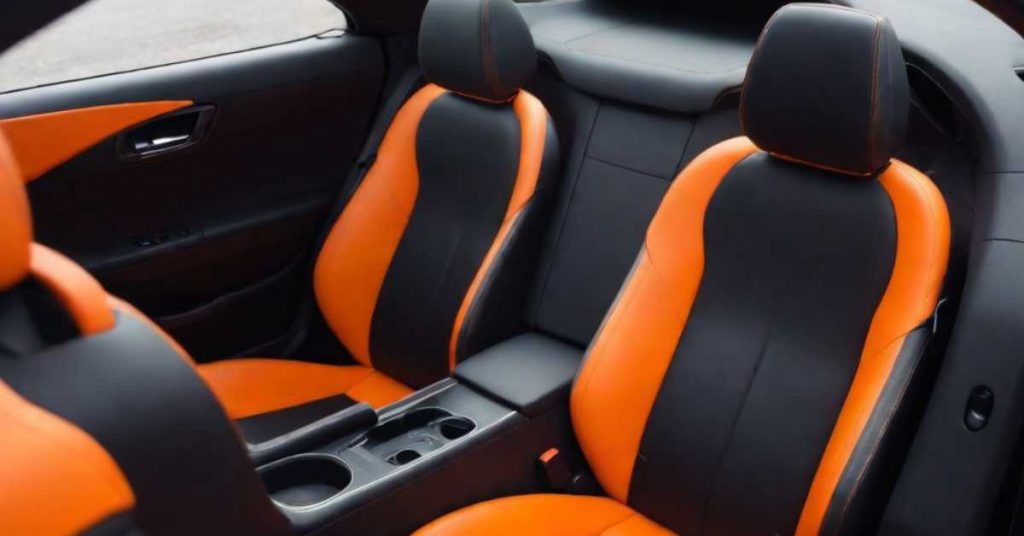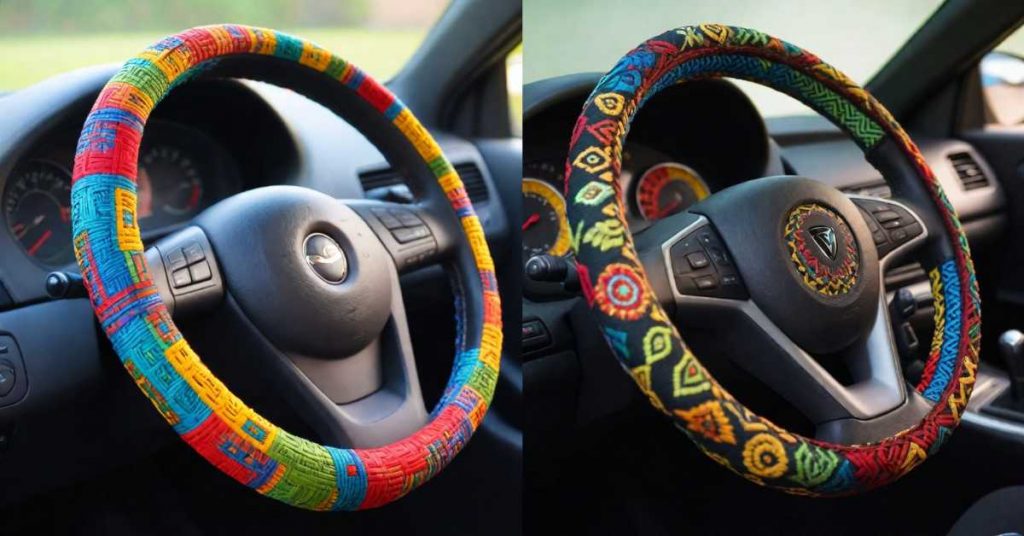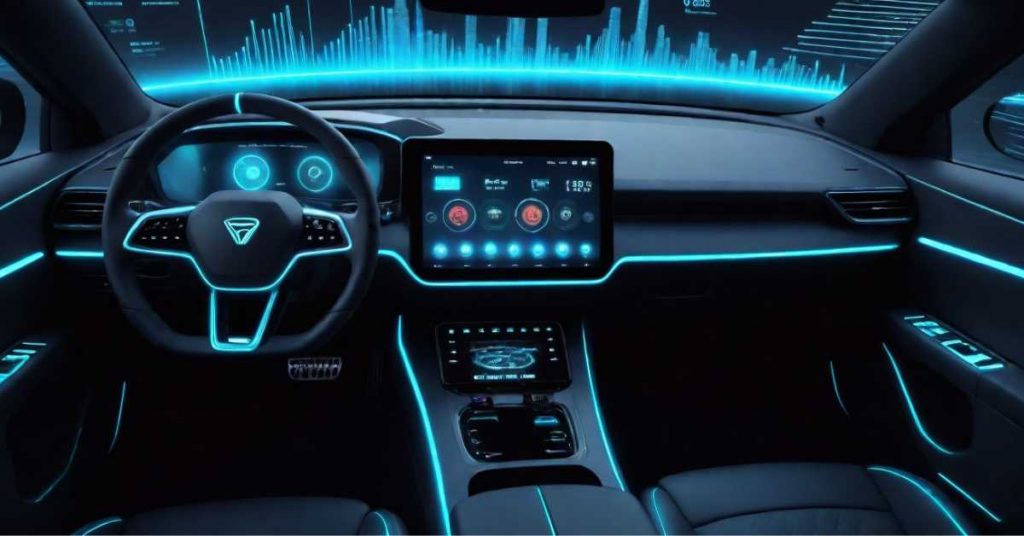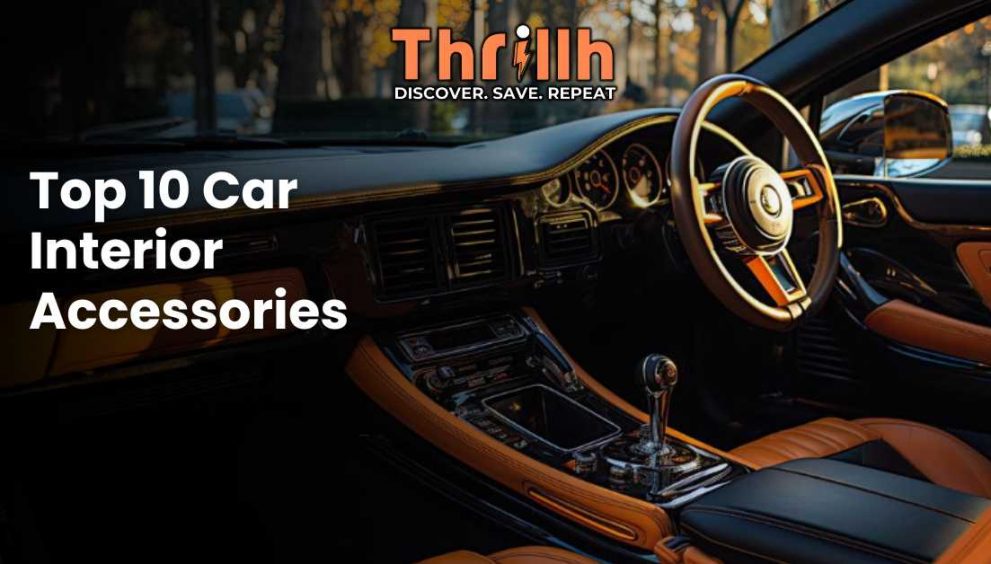Introduction to Car Interior Accessories
Car interior styling transcends mere aesthetics. It’s about creating a personalized environment that echoes your style while enhancing the functionality and comfort of your vehicle. With the right car interior accessories, you can transform even the simplest of interiors into a luxurious, efficient, and enjoyable space.
This introduction delves into the importance of choosing the right car interior accessories that cater to your needs and aesthetic preferences, setting the stage for an improved driving experience.
The Importance of Car Interior Accessories
Enhancing Comfort and Style
The journey matters as much as the destination. High-quality seat covers made from breathable, durable materials can protect your seats and add a touch of personal flair. Ergonomic accessories like support pillows and tailored seat cushions reduce physical stress during long drives, proving that comfort can indeed coexist with style.
Boosting Car Functionality
Functional accessories are pivotal for a streamlined and efficient driving experience. Items like advanced car mounts for smartphones, intuitive multi-functional dashboard systems, and smart organizers that securely store essentials are not just additions but necessities for the modern driver.
Top 10 Must-Have Car Interior Accessories
Custom Seat Covers: Design and Utility

Seat covers are not only an essential accessory for enhancing the comfort and style of your car’s interior, but they also play a crucial role in maintaining its resale value. The variety of materials available for seat covers allows car owners to choose according to their preferences and needs.
Neoprene seat covers are popular for their durability and resistance to water and sun damage, making them ideal for outdoor enthusiasts or those living in harsh climates. They fit snugly over seats, providing a sleek look and protecting the original fabric from wear and tear.
Leather seat covers, on the other hand, add a touch of luxury and comfort. They are highly durable, easy to clean, and age well, often looking better over time. Leather is particularly effective at resisting stains and does not absorb odors, keeping the car’s interior smelling fresh.
Canvas and polyester seat covers are another robust option, especially suitable for families or pet owners. These materials are tough, easy to wash, and can withstand heavy usage, which helps preserve the integrity of the original seats beneath them.
Custom seat covers serve a dual purpose. Aesthetically, they allow personalization of the vehicle’s interior to reflect the owner’s style, from vibrant colors and patterns to elegant, subdued tones. Practically, they protect the original upholstery from damage such as spills, stains, and fading due to sunlight exposure.
This protection is crucial because the condition of the interior is a significant factor in a vehicle’s resale value. Well-maintained interiors often suggest to potential buyers that the car has been looked after carefully, which can positively influence their purchasing decision. By preserving the original upholstery, custom seat covers ensure that the interior remains in optimal condition, potentially increasing the car’s market value when it’s time to sell.
Steering Wheel Covers: Grip and Aesthetics

Steering wheel covers play a vital role in enhancing the driving experience by providing increased comfort, enhanced grip, and protection against wear and tear.
Comfort: Steering wheel covers are designed to make the driving experience more comfortable. Many covers are made from materials like soft leather or cushioned fabric, which provide a pleasant tactile sensation that can reduce hand fatigue on long drives. These materials also help to insulate the steering wheel against extreme temperatures, making the wheel more comfortable to hold in both hot and cold weather.
Enhanced Grip: A good steering wheel cover can significantly improve the driver’s grip on the wheel. This is especially important in situations requiring precise steering. Materials such as silicone or textured fabrics offer a non-slip surface that ensures a firm grip, even when hands are sweaty or the wheel is wet. This enhanced grip can increase safety by providing better control over the vehicle.
Protection Against Wear and Tear: Steering wheels are subjected to a lot of handling, and over time, this constant use can lead to visible wear such as fading, scratches, or peeling. A steering wheel cover acts as a barrier, protecting the original material of the steering wheel from damage caused by direct contact with hands, rings, and other elements. This not only keeps the steering wheel looking new for a longer period but also helps maintain the vehicle’s resale value by keeping the interior in pristine condition.
Overall, steering wheel covers are a practical and stylish addition to any vehicle, providing essential benefits that enhance both the functionality and appearance of the car’s interior.
Ambient Lighting: Setting the Mood Inside Your Car

Ambient lighting can transform the mood of your car’s interior with just a touch of a button. Adjustable settings allow you to choose colors that reflect your mood or enhance visibility for both driver and passengers.
High-Tech Dashboards: A Necessity in Modern Cars

Upgrading to a high-tech dashboard can significantly enhance both the safety and enjoyment of your driving experience. These modern dashboards integrate advanced functionalities into one accessible interface, making various features easier to manage while driving. Here’s how they contribute to a safer and more enjoyable drive:
Enhanced Navigation Systems: Modern dashboards often come equipped with advanced navigation systems that provide real-time traffic updates, route optimization, and easy-to-follow visual and audio directions. This reduces the driver’s need to use a smartphone for navigation, which can be a significant distraction. By keeping your eyes on the road and hands on the wheel, these integrated systems enhance safety and decrease the likelihood of accidents.
Entertainment and Connectivity: High-tech dashboards typically feature integration with smartphones and other digital devices through technologies like Apple CarPlay and Android Auto. This allows drivers to safely control music, podcasts, and other media without taking their hands off the wheel. Voice commands can be used to make calls, send messages, or even control the system itself, adding comfort without compromising safety.
Vehicle Diagnostics: Many advanced dashboards include real-time diagnostics and alerts that keep the driver informed about the vehicle’s health. Features such as tire pressure monitoring, engine performance indicators, and regular maintenance reminders help prevent breakdowns and mechanical failures. By being informed in real-time about any potential issues, a driver can address them before they become serious, ensuring a safer driving experience.
Driver Assistance Features: Upgraded dashboards can also integrate various driver assistance features like adaptive cruise control, lane keeping assist, and collision warning systems. These features work together to augment the driver’s capabilities, reducing the burden of long drives and enhancing safety by providing alerts and automatic intervention in critical situations.
Customizable Interfaces: High-tech dashboards offer customizable interfaces that allow drivers to arrange and display information in a way that best suits their needs and preferences. This can mean a less cluttered and more intuitive layout, making it easier to access essential controls and reducing cognitive load, which leads to a less stressful and more enjoyable driving experience.
Overall, upgrading your dashboard brings a blend of safety, convenience, and technology that not only makes driving less demanding but also more pleasurable and secure.
Essential Car Organizers for a Neat Interior
Car organizers should not be overlooked. From collapsible bins to backseat hangers, these accessories help maintain order and accessibility, ensuring that everything you need is within easy reach.
How to Choose the Right Car Interior Accessories?
Matching Accessories with Car Models and Style
Choosing the right accessories for your car involves a careful balance between enhancing its aesthetic appeal and maintaining, or even improving, its functionality. Here are some tips on how to select accessories that complement your car’s character without compromising its practical use:
1. Understand Your Car’s Style and Theme: Begin by assessing the overall style and theme of your car’s interior and exterior. Is your car sporty, luxurious, or perhaps more utilitarian? Choose accessories that reflect and enhance these inherent qualities. For instance, a sporty car might benefit from sleek, aerodynamic designs with bold colors, whereas a luxury car could be better suited to high-end materials like leather and chrome.
2. Consider Color Coordination: Matching the color scheme of your car can do wonders. Accessories should either complement or thoughtfully contrast with the existing colors of your car’s interior. For instance, if your interior is primarily black, choosing silver, chrome, or even red accents can add a touch of sophistication without overwhelming the overall design.
3. Prioritize Quality and Integration: Opt for high-quality accessories that integrate well with the existing features of your car. Poorly made accessories can detract from both the look and functionality of your vehicle. For example, a well-integrated dashboard cover that fits perfectly will protect against UV rays and reduce glare, unlike a poorly fitting one that might slip and obstruct controls or screens.
4. Functional Fit: Ensure that any accessory you add serves a functional purpose and does not hinder the use of any existing features. For example, smartphone holders, additional cup holders, or seat organizers should be placed where they do not obstruct the driver’s view or access to essential controls.
5. Compatibility with Technology: In modern vehicles, especially those with advanced infotainment systems, it’s crucial to choose accessories that are compatible with existing technology. For instance, if your car has a touchscreen, make sure any protective covers or enhancements do not diminish the screen’s responsiveness.
6. Evaluate Installation Requirements: Consider how the accessory will be installed. Will it require professional installation, or can it be done safely and effectively at home? Accessories that require extensive modification to install may not be worth the risk if they potentially damage the car’s original components.
7. Consider Longevity and Resale Value: Some accessories might look appealing now but could detract from the car’s resale value later or may not be as durable as needed. Evaluate whether an accessory is likely a passing trend or if it will stand the test of time both in style and function.
By keeping these factors in mind, you can choose accessories that not only add personal flair to your vehicle but also enhance its functionality, ensuring that the car remains comfortable, practical, and aesthetically pleasing.
Assessing Quality and Durability in Accessories
When selecting car accessories, prioritizing quality and durability ensures that your investments enhance your vehicle’s functionality and appearance for the long term. Here are some guidelines to help you identify high-quality materials and construction in car accessories:
1. Research Materials: Understand the materials used in the accessories. High-quality materials like high-grade plastics, stainless steel, genuine leather, and durable fabrics are indicators of good quality. Each material has its benefits, such as durability, ease of cleaning, or aesthetic appeal. For example, silicone in phone holders offers flexibility and a good grip, while carbon fiber accessories are both lightweight and strong.
2. Check Build Quality: Examine how the accessory is constructed. Look for solid craftsmanship — seams should be neat and strong, attachments should fit securely without gaps, and movable parts should operate smoothly without sticking or squeaking. Good build quality not only extends the life of the accessory but also ensures it performs as expected without failing prematurely.
3. Read Reviews and Ratings: Leverage customer reviews and ratings which can provide real-world insights into how an accessory holds up over time. Products with consistently high ratings and positive reviews are more likely to be of high quality. Pay special attention to reviews mentioning long-term use and durability.
4. Consider Brand Reputation: Opt for brands known for their quality and customer service. Established brands often offer guarantees or warranties on their products, which can provide additional assurance about the quality of your purchase. These brands tend to adhere to higher standards in materials and manufacturing processes.
5. Look for Certifications: Check if the accessory has any certifications that validate its quality. For example, electronic accessories might have FCC (Federal Communications Commission) approval or compliance with other industry standards, which assures that the product meets certain safety and quality criteria.
6. Test the Fit and Function: Whenever possible, test the accessory to see how well it fits and functions within your car. This is particularly important for items like seat covers, dashboard mats, or custom floor mats. Proper fit is essential not only for aesthetics but also for safety; for instance, improperly fitted floor mats can interfere with pedal operation.
7. Compare Prices and Value: While price isn’t always a direct indicator of quality, extremely low-priced items might be made from inferior materials or might lack the durability needed for automotive use. It’s worth paying a bit more for accessories that are likely to last longer and perform better.
By focusing on these aspects, you can choose car accessories that are both aesthetically pleasing and built to last, ensuring they provide value and function long after the initial purchase.
Installing and Maintaining Car Interior Accessories
DIY Tips for Accessory Installation
Installing car accessories yourself can indeed be a rewarding project. It allows you to personalize your vehicle while saving money on installation costs. Here’s a guide and some tips for safely and effectively adding new features to your car:
1. Preparation and Planning:
- Read the Manual: Before starting, always read the installation instructions provided with the accessory. This helps you understand the tools needed and the steps involved.
- Gather Tools: Make sure you have all the necessary tools for the installation. Common tools include screwdrivers, wrenches, a socket set, pliers, and possibly a drill.
- Prepare the Workspace: Ensure your working area is clean, well-lit, and spacious enough to move around comfortably.
2. Safety First:
- Disconnect the Battery: For installations involving electrical components, disconnect the car battery to avoid any short circuits or electrical shocks.
- Wear Protective Gear: Depending on the task, use gloves, goggles, and other protective equipment to prevent injuries.
3. Follow the Instructions Step-by-Step:
- Take it Slow: Follow the instructions carefully, step by step. Rushing through the installation can lead to mistakes or missed steps.
- Check Fit Before Finalizing: Before final assembly or tightening everything, check that the accessory fits properly and does not interfere with any vehicle operations.
4. Test Before Use:
- Test Functionality: After installation, but before putting everything back together, test the accessory to make sure it works correctly. For example, if you’re installing a new stereo, power it on to check all functions before reassembling the dash.
- Check for Safety: Ensure that the new accessory does not obstruct your vision, access to vehicle controls, or airbag deployment areas.
5. Seek Help if Needed:
- Consult Forums or Videos: If you encounter difficulties, look up forums, videos, or manufacturer’s support for additional guidance. Many car enthusiasts share their experiences and tips which can be very helpful.
- Professional Help: If the installation is beyond your skill level or requires special tools, consider hiring a professional to ensure the job is done safely and correctly.
6. Maintain Documentation:
- Keep Records: Store any warranties, instructions, and receipts related to the accessory. This can be useful for future maintenance or warranty claims.
- Take Notes: If you modified anything during the installation, take notes on what was done in case you need to reverse the installation or make adjustments later.
By following these steps, you can ensure a successful DIY installation of car accessories, adding both functionality and personal flair to your vehicle safely and effectively.
Maintenance Tips – Car Interior Accessories
Maintaining your car interior accessories is crucial for ensuring their longevity and optimal functionality. Here are some simple yet effective maintenance tips to keep your car accessories looking great and working perfectly:
1. Regular Cleaning:
- Use Appropriate Cleaners: Different materials require different cleaning agents. Use cleaners suitable for the material of each accessory to avoid damage. For example, leather cleaners for leather seat covers and mild soap for plastic items.
- Gentle Cleaning Techniques: Avoid abrasive cloths or brushes. Use soft cloths or sponges to prevent scratching surfaces.
- Interior Electronics: For electronic accessories, use microfiber cloths and avoid liquids. If necessary, slightly dampen the cloth with a cleaner designed for electronics.
2. Regular Inspections:
- Check for Wear and Tear: Regularly inspect all accessories for signs of wear, such as cracking, fraying, or loose fittings. Early detection can prevent further damage and potential safety hazards.
- Functional Checks: For electronic accessories, periodically check their functionality to ensure they are working correctly. This includes checking connections, batteries, and any moving parts.
3. Protect from Extreme Conditions:
- Temperature Control: Extreme temperatures can damage certain materials. Try to park in shaded areas or use windshield sun protectors to minimize heat exposure that can warp plastics or fade fabrics.
- Moisture and Humidity Control: Keep the interior of your car dry to prevent mold growth on fabrics and corrosion on electronic components. Using moisture absorbers can help in humid climates.
4. Proper Usage:
- Follow Usage Instructions: Use accessories as intended to avoid undue stress and damage. For example, avoid overloading hooks, hangers, or organizers.
- Educate Others: If you share your car, make sure other drivers and passengers know how to use and care for the installed accessories correctly.
5. Regular Updates and Upgrades:
- Software Updates: For tech accessories, keep software up to date to ensure they function efficiently and securely.
- Replace as Needed: If an accessory is beyond repair or has become obsolete, consider replacing it to maintain safety, functionality, and aesthetics.
6. Professional Servicing:
- Routine Professional Checks: Have accessories checked by professionals, especially for complex installations like alarm systems or high-end audio setups, to ensure they are functioning correctly and safely.
7. Lubrication and Tightening:
- Mechanical Parts: Regularly lubricate any moving parts, and check and tighten fittings to prevent rattles or malfunctions.
By implementing these maintenance tips, you can greatly extend the life and performance of your car accessories, ensuring they continue to enhance both the comfort and functionality of your vehicle over time.
FAQs on Car Interior Accessories
What are the latest trends in car interior accessories?
The latest trends in car interior accessories include ambient lighting systems that change colors, advanced digital dashboards with touchscreen interfaces, and customizable seat covers made from eco-friendly materials.
How can car accessories improve the overall driving experience?
Car accessories enhance the driving experience by increasing comfort (through ergonomic seats and climate control systems), improving functionality (with advanced navigation and parking aids), and personalizing the aesthetic appeal of the vehicle’s interior.
Where to buy top-quality car interior accessories?
Top-quality car interior accessories can be purchased from reputable automotive stores, both online and brick-and-mortar, such as AutoZone, CarID, and Amazon, which offer a wide range of products with customer reviews to help guide your choices.
Conclusion: Enhancing Your Car’s Interior
Investing in high-quality, functional car interior accessories is more than just an aesthetic decision—it’s a choice that enhances your overall driving experience. By selecting the right products, maintaining them well, and integrating them thoughtfully, you can significantly boost both the comfort and functionality of your car’s interior, making every journey enjoyable.





